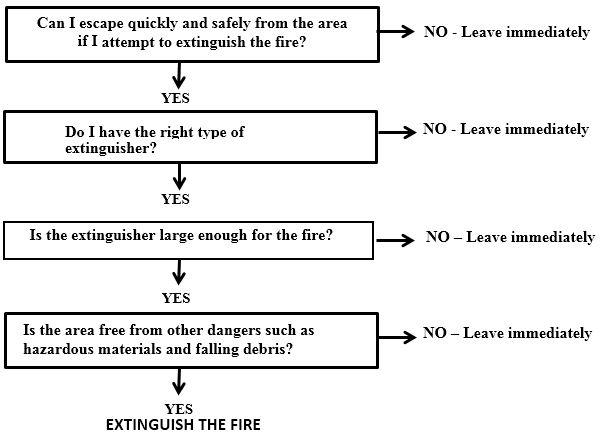Fire Emergencies
In the event of a large scale fire it may be necessary to consider activating the EOC. If the fire is localized then establish a Command Post in a conference room and coordinate activities from there.
- If you discover a fire activate the nearest pull station, evacuate the building, and call the College Sheriff at extension 2911 from a campus phone or (818) 947-2911 from a cell phone.
- Continuous sounding of the alarm signals a building evacuation
- The all clear signal is short blast on the alarm
- All persons should evacuate to the designated Emergency Assembly Point
- Upon discovering a fire, close the door to the room where the fire is located and immediately sound the building fire alarm. Pull stations are located near exits and stairwells.
- If the fire is small (waste basket size), you may wish to fight it with a fire extinguisher or building fire hose. But first sound the alarm. (Follow the Deciding to Use a Fire Extinguisher flow chart later in this section).Be sure you are using the proper extinguisher for the type of fire you are fighting. If the fire is too large or you are uncomfortable or unfamiliar with the proper use of a fire extinguisher, simply close the door and evacuate.
Operation of a Fire Extinguisher
Always operate an extinguisher in an upright position. The acronym to remember when operating an extinguisher is P.A.S.S.:
Pull the pin
Aim at the base of the fire
Squeeze the handle
Sweep the stream at the base of the fire
- If the fire is large, very smoky, or rapid spreading, evacuate the building immediately. Inform others in the building who may not have responded to the alarm to evacuate immediately. The alarm may not sound continuously. If the alarm stops, continue to evacuate. Warn others who may enter the building after the alarm stops.
- If time permits, take purses and bags, lock files, and office doors before leaving. Walk, do not run, to the nearest stairway exit. If you have mobility impairment, request assistance from those nearest you. In the event no one renders assistance, proceed to the nearest stairway landing or smoke tower, shout for help and wait there until help arrives.
- When fire alarms sound, do not use elevators, elevators will return to the 1st floor and be inoperative.
- Notify either the Sheriff or firefighters if you suspect someone may be trapped inside the building.
- Assist disabled persons in exiting the building. Do not use elevators.
- If you become trapped in a building during a fire and a window is available, place an article of clothing (shirt, coat, etc.) outside the window as a marker for rescue crews. If there is no window, stay near the floor where the air will be less toxic. Shout at regular intervals to alert emergency crews of your location. DO NOT PANIC
IMPORTANT: After an evacuation, report to your designated Emergency Assembly Area. Stay there until an accurate HEADCOUNT has been taken. The Building Marshal, Classroom Faculty and Other Supervisory Building Occupants will take attendance and assist in the accounting of all building occupants.

Deciding To Use a Fire Extinguisher
Follow the questions below as a guide for using a portable fire extinguisher during a fire.
Ask yourself each of the questions before attempting to extinguish a fire.
If you answer ―NO to any of these questions:
- Leave the building immediately.
- Shut all doors as you leave to slow the spread of the fire.
If you answer YES to all of the questions, you may attempt to extinguish the fire. If you feel unable to extinguish the fire, however, leave immediately.

Fire type and extinguishing methods chart
- Fire Type: Ordinary Solid Materials
- Extinguishing Agent: Water Foam. Removes heat or removes air and heat.
- Extinguishing Agent: Dry Chemical. Breaks chain reaction.
- Fire Type: Flammable Liquids
- Extinguishing Agent: Foam CO2. Removes air.
- Extinguishing Agent: Dry chemical halon. Breaks chain reaction.
- Fire Type: Electrical Equipment
- Extinguishing Agent: CO2. Removes air.
- Extinguishing Agent: Dry chemical halon. Breaks chain reaction.
- Fire Type: Combustible Metals
- Extinguishing Agent: Special agents. Usually remove air.
Deciding To Use a Fire Extinguisher
- Can I escape quickly and safely from the area if I attempt to extinguish the fire? If no, leave immediately. If yes, go to the next questions.
- Do I have the right type of extinguisher? If no, leave immediately. If yes, go to the next questions.
- Is the extinguisher large enough for the fire? If no, leave immediately. If yes, go to the next questions.
- Is the area free from other dangers such as hazardous materials and falling debris? If no, leave immediately. If yes, extinguish the fire
